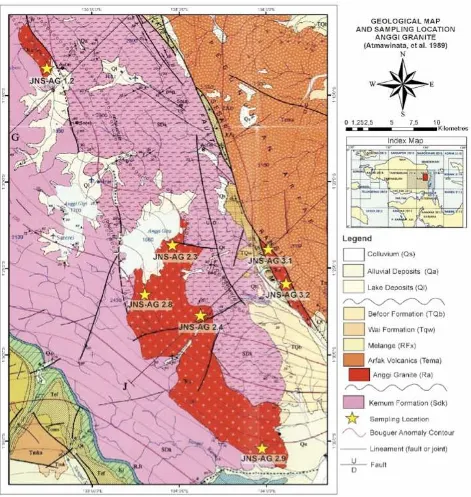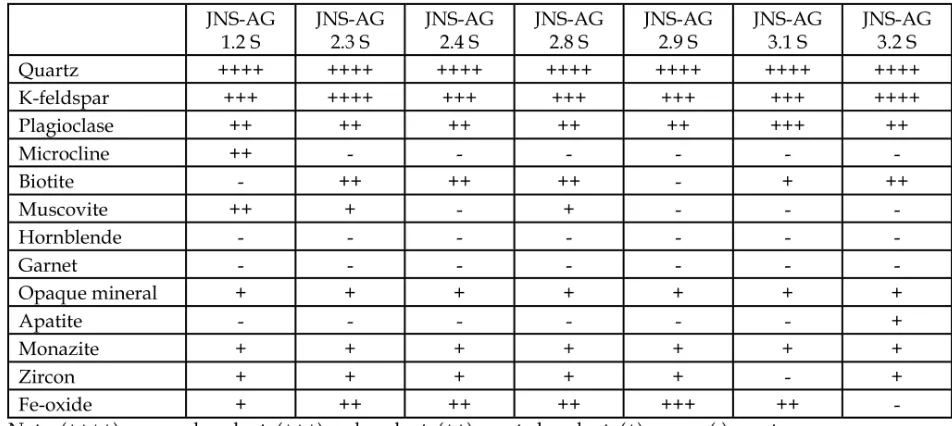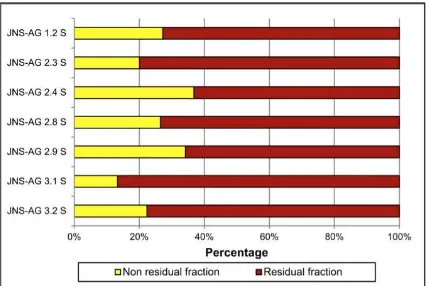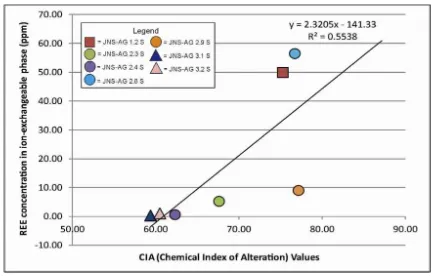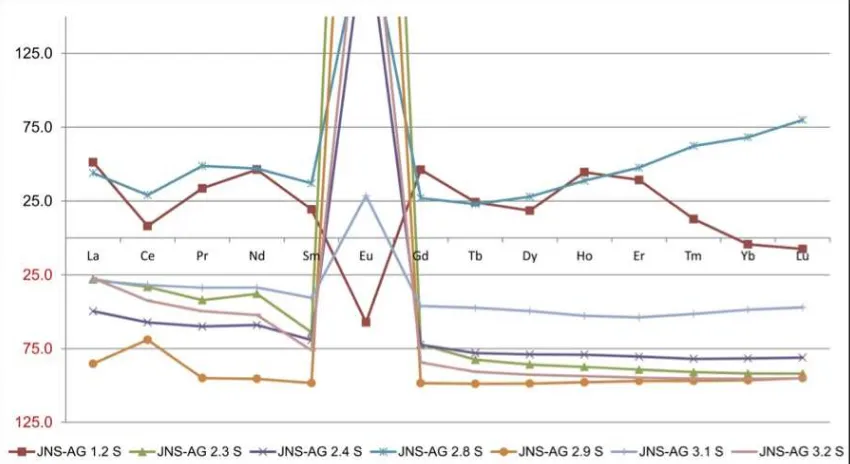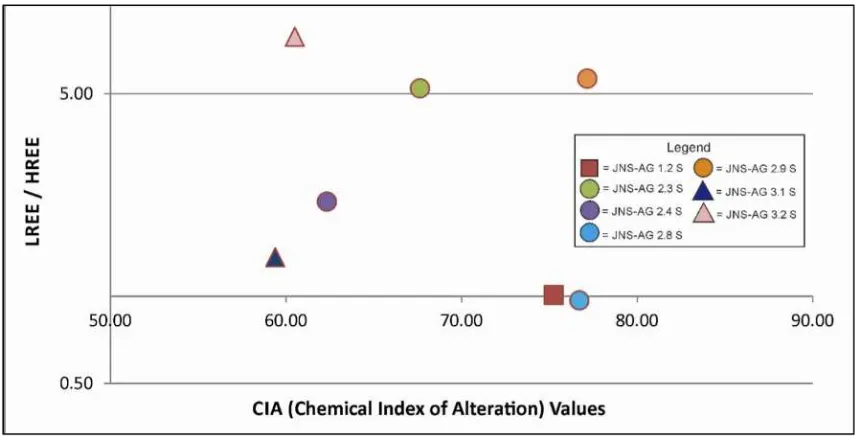SEQUENTIAL EXTRACTION EXPERIMENT OF
REE IN WEATHERED ANGGI GRANITE,
MANOKWARI REGENCY, WEST PAPUA,
INDONESIA
Ega Gita Prasastia∗, Lucas Donny Setijadji, and I Wayan Warmada
Department of Geological Engineering, Gadjah Mada University, Yogyakarta, Indonesia
Abstract
This research objective is to identify geochemical and mineralogical characteristics of Rare earth elements (REE) in the weathering products of Anggi Gran-ite, which is located in Manokwari Regency, West Papua, Indonesia. The research is conducted on 7 samples of fresh rocks and 7 samples of weathered rocks of Anggi Granite. The research analysis con-sists of petrography, XRD, XRF, and sequential ex-traction experiment, supported by secondary data and references. Anggi Granite is S-type and peralu-minous granite that contains zircon, monazite and apatite as a rare earth bearing minerals. Weather-ing products of Anggi Granite do not have a signif-icant enrichment of REE, even some of the samples are depleted in REE. REE in weathered Anggi Gran-ite are dominantly present in the primary minerals, mostly in zircon and monazite. Extractable form of geochemical fractions include crystalline Fe-oxide occluded fraction (ilmenite, hematite and goethite), and ion-exchangeable (illite, kaolin and chlorite). Enrichment of REE in the weathered Anggi Gran-ite is influenced by the presence of resistant REE-bearing minerals, in the forms of zircon and mon-azite, degree of weathering related to the presence of secondary minerals, and other factors such as pH and Eh.
∗Corresponding author: E.G. PRASASTIA,
Depart-ment of Geological Engineering, Gadjah Mada Univer-sity. Jl. Grafika 2 Yogyakarta, Indonesia. E-mail: [email protected]
Keywords: Anggi Granite, REE, Weathering, Se-quential extraction experiment, Geochemical frac-tion
1 Introduction
Rare earth elements (REE) is a group of ele-ments which consist of Lanthanide group with yttrium (Y) (Castor and Hedrick, 2006), al-though some writer also classify scandium (Sc) as REE. Lanthanide is a group of elements with similar behavior and hardly separated from each other. It consists of lanthanum (La), cerium (Ce), praseodymium (Pr), neodymium (Nd), promethium (Pr), samarium (Sm), eu-ropium (Eu), gadolinium (Gd), terbium (Tb), dysprosium (Dy), holmium (Ho), erbium (Er), thulium (Tm), ytterbium (Yb), and lutetium (Lu). Yttrium (Y) is also classified as REE be-cause of the similarity in behavior and occur-rence with Lanthanide (Castor and Hedrick, 2006).
re-place the major elements during magma crys-tallization (Mason and Moore, 1982), so it will has higher concentration in late crystallized ig-neous rocks, or rocks with further differentia-tion processes (Henderson, 1986). Granitic rock is a potential rock that contains high amounts of REE. Weathering processes in granitic rock result the enrichment of REE concentration as laterite deposit (Bao and Zhao, 2008).
Anggi Granite in West Papua is one of the granitic rocks in Indonesia which could have a high potential of REE. It is located in Anggi Dis-trict, Manokwari Regency, West Papua, Indone-sia (Figure 1). Tropical climate condition, which is typical in Indonesia area, creates weathering products in the surface of the granitic rocks. In the weathering products, REE present in dif-ferent geochemical form than that of in fresh rocks. REE can present in primary minerals, or dissolved then bonded by secondary miner-als or leached to other parts of the soils, which also affect the enrichment of REE. Mineralogy and geochemistry of rare elements, therefore become an important factor to analyze the po-tential and mineral target of REE in the weath-ered Anggi Granite. The controlling factors in the REE enrichment and characteristics of REE in the weathering products, especially in gran-ite is also studied.
2 Geologic setting
The geology of West Papua generally consists of metamorphic rocks as a basement, known as Kemum Formation, intruded by some plu-tonic rocks, which are overlaid by some for-mations of pyroclastic and sedimentary rocks (Pieterset al., 1990). Those plutonic rocks con-sist of Melaiurna Granite, Maransabadi Granite, Kwatisore Granite, Wariki Granodiorite, War-jori Granite, Netoni Intrusive Complex, and Anggi Granite. The three later are located along Sorong Fault Zone in the eastern part of West Papua Bird’s Head.
Anggi Granite, which become the concern in this research, present in form of three intru-sive bodies, consists of Didohu, Testega and Neney Granites, which is mentioned by Sarira (2013). Anggi Granite intruded Kemum
For-mation and was been overlaying by Wai and Befoor Formation (Pieters et al., 1990). Anggi Granite is dominated by muscovite and biotite granite, but quartz diorite, aplite and pegmatite are also found locally (Pieterset al., 1990). Pet-rogenetic research of Anggi Granite by Sarira (2013) proved that Anggi Granite is a peralu-minous S-type granite. From K-Ar dating by Bladon (1998, vide Pieterset al., 1990), the age of Anggi Granite ranges from 227 to 248 Ma, whereas according to Harahap et al. (1998) it has the age of 227–295 Ma.
3 Methods
The analysis of this research was done on fresh rocks and weathered samples of Anggi Granite. The samples was taken from eight (8) location, which is located on the outcrop of Anggi Gran-ite intrusive bodies, consist of Didohu Anggi Granite (sample JNS-AG 1.2), Testega Anggi Granite (samples AG 2.3, AG 2.4, JNS-AG 2.8, and JNS-JNS-AG 2.9), and Neney Anggi Granite (samples JNS-AG 3.1 and JNS-AG 3.2). Figure 1 showed the samples location in the re-search area. One sample of fresh rock and one sample of weathering product were taken in each location to be analyzed.
All samples were analyzed by ICP-MS method, conducted in Activation Laboratories, Canada to elucidate the composition of REE in each sample. Fresh rock samples were ana-lyzed by polarizing light microscope to under-stand the texture and composition of the rocks, especially the presence of REE-bearing acces-sory minerals. Furthermore, X-ray Diffraction (XRD), petrographic analysis, X-Ray Fluores-cence (XRF) and a sequential extraction based to Miller et al. (1986) with modification have been conducted in the Faculty of Engineering, Kyushu University, Japan.
4 Results and discussion
Mineralogy and weathering process of Anggi Granite
with various abundances, while accessory min-erals dominated by muscovite and/or biotite. REE-bearing accessory minerals presents as zir-con and monazite in all rock samples, whereas apatite is only found in one sample (JNS-AG 1.2 R) (Table 1). The observation of weathered rock sample of Anggi Granite, as well as the cal-culation of CIA (Chemical Index of Alteration) (Nesbitt and Young, 1982 vide Bao and Zhao, 2008) showed that Anggi Granite was not inten-sively weathered. Sample JNS-AG 2.9 S has the biggest CIA value, followed by JNS-AG 2.8 S, AG 1.2 S, AG 2.3 S, AG 2.4 S, JNS-AG 3.2 S, and the last one is JNS-JNS-AG 3.1 S.
Petrography and XRD analysis shows that weathered products of Anggi Granite still con-tain primary minerals of the fresh rocks, such as quartz, orthoclase, plagioclase, muscovite and biotite, although the amount of these minerals, except quartz, decrease significantly. Monazite and zircon are also still presence, but apatite is no longer exist (Table 2). Secondary minerals as a result of weathering present as clay min-erals, such as illite and kaolin, with high inten-sity in samples JNS-AG 1.2 S and JNS-AG 2.8 S. Fe-oxide is also commonly presence as a re-placement of biotite, whereas goethite present in sample JNS-AG 2.9 S.
REE Mineralogy
REE can present in granitic rock in relatively big proportion, compared to other igneous rock, ex-cept for pegmatite and carbonatite, which con-tain large proportion of REE (Henderson, 1986; Castor and Hedrick, 2006). The proportion of REE is related to the differentiation process of the igneous rock (Henderson, 1986). Except for quartz, all of the primary minerals in igneous rocks, especially granitic rocks, contain REE in various proportions. However, REE are more concentrated in the accessory minerals such as sphene, apatite, zircon and monazite (Hender-son, 1986; Yusoff, et al., 2013). In the case of Anggi Granite, accessory minerals consist of apatite, monazite and zircon (Table 1) and REE will dominantly consist in those accessory min-erals.
During the weathering process, primary and accessory minerals which contain REE will
dis-solve and secondary minerals are formed. REE that is freed from primary minerals during weathering processes then makes a bond with secondary minerals. Secondary minerals tie REE with different process and depend on the chemical and structural composition (Yusoffet al., 2013). Sequential extraction analysis was done to separate heavy metals, including REE, from each geochemical fraction, thus elucidate the dominant geochemical form of REE in the soil. In the sequential extraction analysis of Anggi Granite, extractable REE consist only of 20.1–36.8% from total REE in the weath-ered rock samples, and the non-extractable part (63.2–79.9%) include in the residual form (Fig-ure 2). REE in the residual form is incorporated in the stable crystal structure of minerals, par-ticularly primary minerals which have not been destroyed or changed during weathering pro-cess.
crys-Table 1: Abundances of primary and accessory minerals in Anggi Granite samples, based on petro-graphic analysis (units in %).
Figure 2: Percentage of residual fraction in weathering samples of Anggi Granite from sequential extraction analysis.
talline Fe-oxide, only contain small amount of REE.
Ion-exchangeable fraction dominantly is con-tained only in sample AG 1.2 S and JNS-AG 2.8 S. Both samples are characterized by high CIA values, and also the presence of clay minerals. Samples AG 3.1 S and JNS-AG 3.2 S which have small CIA values almost do not contain ion-exchangeable fraction. Fig-ure 3 presents the relation between degrees of weathering with the intensity of REE in ion-exchangeable fraction, which shows the simi-lar pattern. Meanwhile, sample JNS-AG 2.9 S which has similar CIA values with JNS-AG 1.2 S and JNS-AG 2.8 S do not contain a significant amount of ion-exchangeable fraction. Apart from that, ion-exchangeable fraction is sensitive to pH change (Hu et al., 2008). The acid pH condition in JNS-AG 2.9 S will easily break the cation bond of ion-exchangeable fraction.
Clay minerals generally act as
ion-exchangeable (Huet al., 2008), which in Anggi Granite samples consist of illite, chlorite and kaolin. Ion-exchangeable fraction more readily
adsorbs LREE than HREE (Yusoff et al., 2013), since LREE affinity to clay minerals is higher than HREE (Bao and Zhao, 2008). However, HREE can contain in high amount in this frac-tion when it is abundant in the weathering soil (Bao and Zhao, 2008), which result in the rela-tive enrichment of HREE in sample JNS-AG 2.8 S.
Figure 3: Graphic of relationship between degree of weathering (represent by CIA values) and REE contents in the ion-exchangeable fraction in the weathering samples of Anggi Granite.
Analyzed weathering samples in this research are taken from soil zone C and not fully weath-ered, which result in small amount of REE in organically bound fraction. Metal in this frac-tion consist in organic material which generally present in soil zone A, where detritus and or-ganism activities are commonly present (Okoro et al., 2012).
Geochemical characteristics of REE in Anggi Granite
Mass balance equation of Nesbitt (1979, vide Yusoff et al., 2013), was used with normaliza-tion on Zr, which is considered as immobile el-ement. The result presents that all weathered sample of Anggi Granite were depleted in REE, except for sample JNS-AG 1.2 S and JNS-AG 2.8 S. The enrichment pattern of weathered sample also shows that JNS-AG 1.2 S and JNS-AG 2.8 S were enriched in all REE, while the other sam-ples show different patterns (enrichment only of LREE in sample JNS-AG 2.3 S and JNS-AG 3.2 S, depletion pattern in sample JNS-AG 2.4 S,
JNS-AG 3.1 S and JNS-AG 2.9 S (Figures 4 and 5).
Leaching process dominantly occurred in HREE (Gd, Tb, Dy, Ho, Er, Tm, Yb, Lu, and Y), as it is more mobile than LREE (La, Ce, Pr, Nd, Sm, and Eu) (Bao and Zhao, 2008; Huet al., 2006; Maet al., 2007). Generally HREE was not much accumulated in the weathered granites with negative percentage of abundance changes (Figure 5). This is result in much greater REE fractionation in weathered samples than fresh rocks, except for JNS-AG 1.2 S and JNS-AG 2.8 S. Those two samples were enriched and had accumulation in HREE. This is due to pH con-dition, which is suitable for the deposition of REE into secondary minerals. Some ions, such as complex carbonate, also have high affinity in HREE which caused HREE mobilization and transportation to the deeper zone of weathering profile (Yusoffet al., 2013). HREE enrichment in the weathered granite can also be caused by zir-con, as a HREE-bearing mineral, accumulation (Sanematsu, 2009).
Figure 4: Spider diagram of REE normalization in the weathering products toward the fresh rocks of Anggi Granite (normalization by C1-chondrite abunandces according to McDonough and Sun, 1994).
rocks, compared to the fresh rocks. LREE was more enriched because it more compatible and will stay longer in the weathering profile. Some secondary minerals such as clay minerals and Fe-oxyhydroxide also have higher affinity for LREE (Koeppenkastrop and de Carlo, 1993; White, 2000; Comptonet al., 2003 vide Yusoffet al., 2013). Positive Ce anomaly is presented in sample JNS-AG 2.9 S. Ce anomaly is caused by the difference in the oxidation value in cerium. It can present in the oxidation value +4 (Ce4+
) in the oxidation state, which is relatively immo-bile than Ce3+
(Bao and Zhao, 2008; Braunet al., 1989; Yusoffet al., 2013), and also tend to make a bond with oxygen to create cerianite mineral (Price et al., 1991). Oxidation state in sample JNS-AG 2.9 S was supported by the presence of goethite as a secondary mineral. Braun et al. (1990) stated that environment condition for goethite to be formed is similar to cerianite, ac-cording to the pH and Eh values.
Meanwhile, Eu had a positive anomaly and significant enrichment in the weathered sam-ples. In granitic rocks, Eu has a high affin-ity in feldspar, since it has +2 oxidation value (Henderson, 1984). Because of feldspar weath-ering, Eu was mobilized and accumulated in the weathering profile. Weathered sample of Anggi Granite also still contain high amount of feldspar. The accumulation of the feldspar it-self can contribute to the Eu enrichment. The depletion REE pattern of Eu in sample JNS-AG 1.2 S can be influenced by activity of humic and flufix acid and create Eu(III)–humate complex, which is more mobile than other REE (Nagaoet al., 1996; Donget al., 2001; Wang and Dong, et al., 2001 vide Huet al., 2006).
Factors controlling mineralogy and geochem-istry of of REE
Generally, there are two factors that influenced mineralogy and geochemistry of REE in weath-ered products of Anggi Granite: 1) geochemi-cal characteristic and mineralogy of the rock; 2) weathering process and condition.
Different geochemical characteristics in ig-neous rock would create different mineralogy
by Alumina Saturation Index (Bea, 1996). Ac-cording to Bea (1996), in peraluminous granitic rock, REE are mostly incorporated in accessory minerals, such as monazite, xenotime, zircon and apatite, which are also present in Anggi Granite samples, except for xenotime. Those minerals, except for apatite, are resistant, thus would survive in weathering process. Release of REE in the weathering products would re-sult to REE mobilization, which would lead to REE enrichment and fractionation. In Anggi Granite this mobilization did not intensively happen, so high REE enrichment and fractiona-tion was harder to be found, compared to met-aluminous granite, which contain REE in non-resistant minerals, such as alanite.
Degree of weathering become one of the fac-tors influencing mineralogy and geochemistry of REE in weathered granite. This research shows a relation between degree of weathering, which is shown by CIA (Chemical Index of Al-teration) value, with REE enrichment (Figure 6) and fractionation (Figure 7). However, some erratic values are also found, probably due to influence of other factors, such as pH and Eh condition of weathering products. For exam-ple, sample JNS-AG 2.9 S does not experience significant enrichment due to leaching process in the acid pH environment (Figure 7). REE precipitation is highly influenced by pH condi-tion except for Ce and Eu, which are also influ-enced by oxidation state (Braun et al., 1990). In the other hand, samples AG 1.2 S and JNS-AG 2.8 S do not have great fractionation value, because it became the accumulation place for HREE.
Figure 6: Plotting of CIA versus LREE/HREE ratio showing a good relationship between degree of weathering (represented by CIA values) and REE fractionation in the weathering samples of Anggi Granite.
The weathering products of Anggi Granite did not experience significant enrichment. REE en-richment in the samples were caused by rela-tive enrichment in samples JNS-AG 2.3 S and JNS-AG 3.2 S, and absolute enrichment in sam-ples JNS-AG 2.8 S, while the rest are depleted in REE. The absolute enrichment happen because the accumulation of REE in the reduction envi-ronment, and the depletion is caused by leach-ing process durleach-ing weatherleach-ing.
LREE/HREE values were increased in the weathering samples of Anggi Granite, because HREE were leached more than LREE, except for sample JNS-AG 1.2 S and JNS-AG 2.8 S which become the accumulation zone of HREE. Meanwhile, positive cerium anomaly occur in sample JNS-AG 2.9 S, caused by suitable ox-idation and pH condition for cerianite to be formed, which is characterized by the presence of goethite in the sample. REE in weathering products of Anggi Granite still dominantly con-tain in REE-bearing primary minerals such as zircon and monazite, while the rest consist on crystalline Fe-oxide fraction (ilmenite, hematite and goethite), and ion-exchangeable fraction (clay minerals illite, kaolin and chlorite).
Geological factors that influence the geo-chemical and mineralogical characteristics in the weathering samples of Anggi Granite are geochemical characterization of fresh rocks, which influences the kind of REE-bearing min-erals in the rock, degree of weathering which is related to the presence of secondary miner-als, especially clay minerminer-als, and other factors related to pH and Eh condition.
Acknowledgements
This work was undertaken at Chemical Analy-sis Laboratory, X-ray Laboratory and Center of Advance Instrumental Analysis, Faculty of En-gineering, Kyushu University. We thank Prof. Koichiro Watanabe for the chance given to us and Dr. Kotaro Yonezu for the helping and guidance during laboratory analysis in Kyushu University.
Bao, Z. dan Zhao, Z. ( 2008) Geochemistry of mineralization with exchangeable REY in the weathering crust of granitic rocks in south China. Ore Geology Reviews 33: 519–535. Bea, F. (1996) Residence of REE, Th, and U in
granites and crustals protoliths; implications for the chemistry of crustal melts. Journal of Petrology 37: 521–552.
Braun, J., Pagel, M., Muller, J., Bilong, P., Michard, A., Guillet, B. (1990) Cerium anomalies in lateritic profiles. Geochimica es Cosmochimica Acta 54: 781–795.
Castor, S. B., Hedrick, J. B. (2006) Rare Earth El-ements. Industrial Minerals 7thedition, Soci-ety for Mining, Metallurgy, and Exploration, Littleton, Colorado.
Filgueiras, A.V., Lavilla, I., Bendicho, C. (2002) Chemical sequential extraction for metal par-titioning in environmental solid samples. Journal of Environment Monitoring 4: 823– 857.
Harahap, B.H., Hakim, A.S., Hartono, U. (1998) Upper Paleozoic-Lower Mesozoic magmatic intrusions in Western Irian Jaya. Jurnal Ge-ologi dan Sumber Daya Mineral 8:2–13. Henderson, P. (1986) Rare Earth Elements
Geo-chemistry, Elsevier Science Publishers B.V., Netherlands.
Hu, Z., Haneklaus, S., Sparovek, G., Schnug, E. (2006) Rare earth elements in soils. Commu-nications in Soil Science and Plant Analysis 37: 1381–1420.
Ma, L., Jin, L., Brantley, S.L. (2007) How min-eralogy and slope aspect affect REE release and fractination during shale weathering in the Susquehanna / Shale Hills Critical Zone Observatory. Chemical Geology 290: 31–49. Mason, B., Moore, C.B. (1982) Principles of
Geo-chemistry. 4thEdition, John Wiley and Sons, Inc., New York.
McDonough, W.F., Sun, S. (1995) The composi-tion of the earth. Chemical Geology 120: 223– 253.
Okoro, H.K., Fatoki, O.S., Adekola, F.A., Ximba, B.J. Snyman, R.G. (2012) A review of sequen-tial extraction procedures for heavy metals speciation in soil and sediments. Open acces scientific reports, vol. 1, issue 3.
Pieters, P.E., Hakim, A.S., Atmawinata, S. (1990) Geologi Lembar Ransiki, Irian Jaya, Pusat Penelitian dan Pengembangan Geologi, De-partemen Pertambangan dan Energi, Ban-dung.
Price, R.C., Gray, C.M., Wilson, R.E., Frey, F.A., Taylor, S.R. (1991) The effects of weathering on rare-earth element, Y and Ba abundances in Tertiary basalts from southeastern Aus-tralia. Chemical Geology 93: 245–265.
Sanematsu, K., Murakami, H., Watanabe, Y., Duangsurigna, S., Vilayhack, S. (2009) En-richment of rare earth elements (REE) in
granitic rocks and their weathered crusts in Central and Southern Laos. Bulletin of the Geological Survey of Japan 60: 527–558. Sarira, J.N. (2013) Petrogenesa dan Potensi
Mineralisasi pada Granit Anggi, Kabupaten Manokwari, Propinsi Papua Barat, Thesis, Jurusan Teknik Geologi Universitas Gadjah Mada, Yogyakarta.
Tessier, A., Campbell, P.G.C., Bisson, M. (1979) Sequential extraction procedure for the spe-ciation of particulate trace metals. Analytical Chemistry 7: 844–851.
